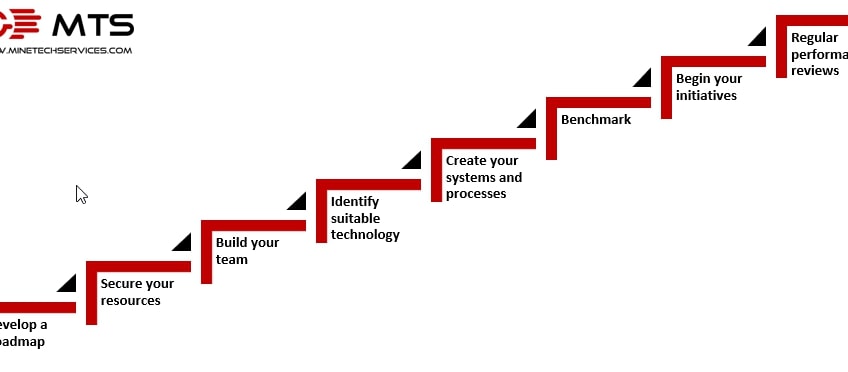Five Tips for Establishing a Successful Asset Health Programme. In this blog, we provide some handy tips on how to get started.
Five Tips for Establishing a Successful Asset Health Programme
Establishing and maintaining a world-class asset health programme in the mining industry is no easy task. Pulling all the moving parts together requires a strong spirit of collaboration and cooperation amongst stakeholders, equipment manufacturers, equipment dealers and mining departments.
In this blog, we provide some handy tips on what you should consider when starting up your own asset health management programme.
Take the Stair-Step Approach to Digital Transformation
We truly believe that taking a stair-step approach with multiple short, sharp projects can yield significant results. We’ve worked with many operations around the world who have used this method, resulting in a marked improvement in their equipment availabilities, with minimal stress along the way.
Don’t Try to Run Before you Can Walk
Don’t try and leap forward too quickly. In our experience, this results in a lengthy project, risking scope creep, significant change management and increased chances of failure. A flashy project involving some of the current industry buzzwords like Big Data and Machine Learning may look great in a press release, but full digital transformation in the mining industry simply will not work unless the proper foundations are in place.
There is No Silver Bullet for Digital Transformation in Mining
We’ve seen many companies (who are struggling just to run planned services on-time) try to implement hugely complex and expensive digital transformation strategies which ultimately failed.
Why? Because they didn’t ensure the basics were in place.
- Ensure you have full buy-in. Mining technology and asset health management programmes fail when they are forced upon people who aren’t really interested in them because they don’t see the value.
- Pick the right team for the job. Attitude is everything, so invest in supporting the talent you do have with the right mix of skills.
- Go external for missing technical skills. It will pay dividends if you don’t have internal resources and expertise to get things done on time.
- Establish standard workflows and standard operating procedures. These are typically overlooked as unnecessary bureaucracy, but without them, you risk everybody doing their own thing.
- World-class people and facilities can easily underperform if there are no parts in the warehouse. For remote sites, this is even more critical.
- Invest in the tools, systems, and technology that suit your operation. Are multiple, complex spreadsheets really the best way of mass-communication within large organisations? Is a cloud-hosted solution robust enough for a remote site with poor network connectivity?

Asset Health Management: Identify and Define what you Want to Achieve
If you cannot measure results, then you cannot manage effectively. When defining a set of metrics to measure performance of your asset health management program, consider the following:
Availability – Overall, how much is the machine down for all types of maintenance. What should it be down for during this life period? (i.e., brand-new Vs mid-life).
MTBS – Mean Time Between [maintenance] Stoppages – Ideally this would match or exceed the interval for Preventive Maintenance. This would imply that scheduling and opportune maintenance are occurring.
Unscheduled Downs Vs. Schedule Downs % – Machines have to stop at some point for maintenance but breaking down mid-cycle on the haul road is obviously not desired. This metric is useful to understand where the stoppages are coming from.
Work Hours Expended for Each Down Hour – If you are able to plan and mobilise service work at opportune moments the ratio will be high, which is good.
We recommend that metrics are tailored to each role or team and are balanced to minimise the risk of driving the wrong behaviour. Also, consider establishing a pre-initiative or programme baseline, as this can be useful in progress evaluation and demonstrating value to stakeholders later in the project.
Establish a Roadmap for Digital Transformation in the Mining Industry
When undertaking any mining technology programme that involves substantial investment, change management and multiple stakeholders, we recommend establishing a Roadmap.
This is a formal document with clearly defined goals, milestones, roles, resources and risks. The roadmap serves not only as the backbone of the project but also as a platform upon which the project can evolve in a sensible, controlled manner.
We hope that this month’s blog has given you some points to consider in establishing or reinvigorating your own asset health management programme.
If you have any comments or would like to know more about how we could help your mining digital transformation, drop us a line at [email protected]
[DISPLAY_ULTIMATE_SOCIAL_ICONS]

